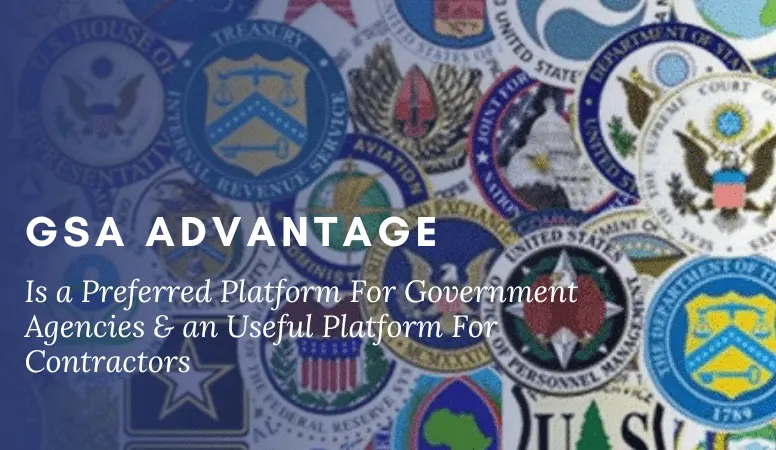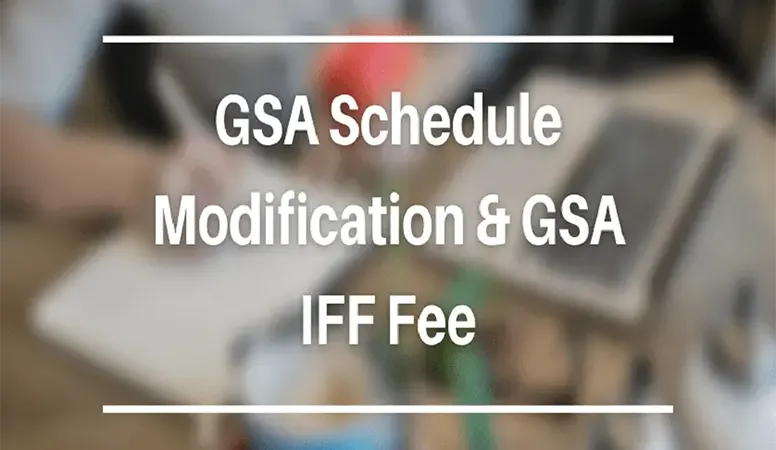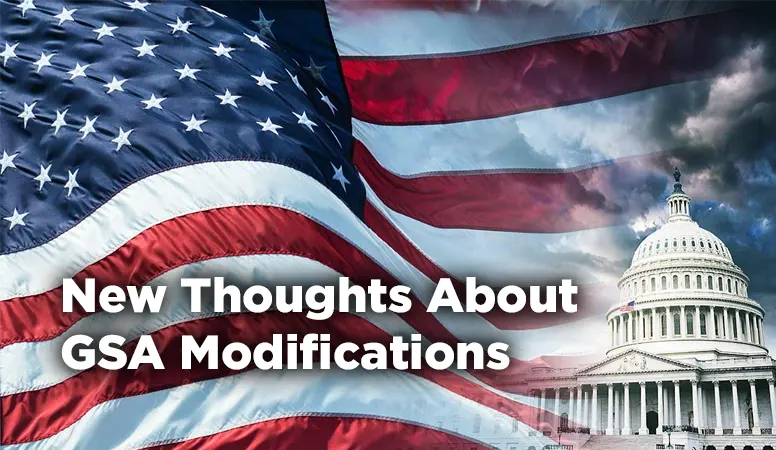
Preparing and Researching with GSA Pricing Schedule
There are several factors to keep in mind when obtaining and maintaining a GSA Schedule contract. One of the most important aspects of a GSA Schedule is the pricing. There is a whole section of your GSA proposal dedicated to this. One of the biggest reasons federal customers use the Multiple Award Schedule (MAS) program is assurance that the pricing and products have been vetted and reviewed, which is why it’s so important to spend some time reviewing this information. If you have a solidified understanding of the pricing requirements before going into negotiations with your Contracting Officer, it'll set your company up for success in the future. Throughout the course of this post, we will going over what GSA pricing schedule is and the different factors that go into determining your costs.
GSA Schedule pricing is handled as fixed maximum costs are awarded for provisions. Administrations are estimated at either hourly rates or at fixed costs for explicit assignments. The Contracting Official (CO) determine their GSA Schedule Pricing & Discount recommendations by researching Competitors already on GSA. Estimating to be reasonable and sensible before awarding the contract.
GSA Schedule prices are to not-to-surpass, maximum price tags, and contractors set up Schedule costs with all request sizes, types, complexities, topographical locales, and so forth, at the top of the priority list, envisioning the chance to limit costs at the request level.
Explicit motivations to look for value decreases incorporate;
- Cases where the buyer has established that a stockpile is accessible at a lower cost somewhere.
- While setting up a BPA to fill repeating prerequisites and the potential volume of requests under BPAs offers the opportunity to verify value decreases, paying little respect to the size of individual requests, or
- The request is over the most extreme request limit
- Contractors might be persuaded to offer lower GSA Schedule Pricing dependent on other factors. This includes focused powers, innovative changes, work conditions, industry deals objectives, and stock decreases.
- Federal Buyers are required to look at some price decrease for all requests or BPAs that surpass the Streamlined Obtaining Limit (SAT). This necessity applies to all Schedule requests or BPAs over the SAT, paying little mind to the degree of rivalry, limits offered at the Schedule level, kind of item or administration being obtained, or some other variables encompassing the acquisition.
The GSA pricing schedule is resolved through exchange for each contract, great or small,. This additional step sets conveyance, guarantees timelines and different terms that apply to the contracts. This enables spare to time, eliminates copied exertion and limits administrative work.
the offeror’s business deals is what the contract is to be evaluated on. In this way, we start with the offeror’s current, dated Business Value Rundown (CPL) or business showcase estimating. The offeror at that point distinguishes its Most Supported Clients (MFCs) and the markdown offered to the MFCs.
The offeror decides the markdown to be offered to GSA at that point. The cost to be offered to GSA includes two estimations: the first bars the Modern Subsidizing Expense (IFF); the second incorporates the IFF.
What is the Industrial Funding Fee?
Take the final GSA prices for the GSA Schedule Contractor, and a small fee. This is what federal buyers are charged. Right now, the IFF is 0.75 percent. The GSA Schedule holder should report her/his GSA deals inside 30 days after the end of each quarter through the 72A Revealing Framework. The GSA Schedule holder is additionally expected to calculate and pay the IFF.
GSA Reporting
There are two reports that are basic for the valuing for the GSA Schedule contract. The first is the Business Deals Practices (CSP) group. Regularly, this is Archive 9 in the requesting bundle. The CSP has one structure for administrations and another for items.
The two structures must show the all out anticipated yearly deals to the Government for every Uncommon Thing Number (SIN) advertised. The Transgressions are the numbers under every GSA Schedule that show the class of item or administration to be advertised.
Preparing & researching your GSA pricing schedule
There are two tools to help you research where your GSA Scehduel Pricing lands:
- PRODUCTS – The GSA pricing schedule for products can be researched extensively on GSA Advantage
- SERVICES – The GSA pricing schedule for services or Labor Categories can be researched extensively using the GSA CALC TOOL
In the event that the potential Schedule holder is a vendor/affiliate of an item, a Letter of Duty/Supply from the producer will be vital. The Value Proposition is the subsequent report. Ordinarily, this is Report 8 in the requesting bundle. The layout for the most part contains three organizations: the first for administrations, the second for preparing, and the third for items.
The preparation design has sections for Course Title, Course Length, Least Members, and Most extreme Members. The items group has sections for Help Item (ODCs), Brand Name, and Time Conveyance.
Something else, the segments to be finished are comparative for the three configurations: SIN(s) Proposed, Business Value Rundown (CPL), Unit of Issue, Most Supported Business Client (MFC), Markdown Offered to Business MFC, Business MFC Value, Rebate Offered to GSA (off CPL or Market Costs, Value Offered to GSA (barring IFF), and Value Offered to GSA (counting IFF).
HOW TO BUILD YOUR GSA PRICING SCHEDULE STRATEGIES
The GSA pricing schedule policy implies that a vendor must offer its best price to the government. Specifically, You should offer the GSA at least the same or better prices that you do to your Most Favored Customer (MFC). Unfortunately, this clause is often interpreted as “the lowest possible price.” Wrong.
The problem with just providing a bigger discount to GSA is that you can easily render your entire business with the government non-profitable. Hundreds of companies have fallen victims to this Catch-22: you must offer low prices to win the bid, but by offering low prices you undermine your own business, thereby making the whole bid-and-win process pointless. Surely, lower prices for federal agencies mean savings for the American taxpayer, but chasing the lowest bid only for the sake of staying the lowest, is not efficient.
In fact, the proper approach to setting your GSA contract rates is… to not look at the others’ prices! Well, not from the beginning. The fact is: you don’t know the structure of your competitor’s prices. You do not know their direct and indirect costs, including labour, materials, transport, and other expenditures. Hence, trying to beat their bids straight forward has no chance to succeed.
GSA PRICING SCHEDULE
The better option to complete your GSA price list is to evaluate your own rates, costs, and surplus your desirable profits. Then, you can research for current or past bids, using GSA Advantage, USASpending.gov or govspend.com tools, see if you can compete without going broke, and meet the requirements of GSA at the same time. You can also use the GSA Integrated Competition Tool for that.
Also, remember that bidding the lowest is only halfway to securing a contract. Whenever you respond to an RFQ, you will eventually have to provide evidence in the form of Price Narrative and Price Proposal documents.
Q: What is “Fair and Reasonable” Pricing?
A: Fair and reasonable pricing is an important concept you need to understand in order to successfully sell to the government. The idea behind this notion is that the government gives preference to the lowest price as soon as all other factors are equal. Then, the lowest prices must not exceed the company’s prices on the commercial market, because the government is a special client. Hence, when you pursue a GSA Schedule, you must preliminarily disclose your commercial price list, and offer the same or better price to the government. Such an offering is considered “fair and reasonable”. You can negotiate higher prices, but there must be a substantial reason for you to ask more from the government than you do from your commercial clients. That’s what “reasonable” is about, in this context. And the contracting officer will determine the fairness and reasonableness of your offer, based on similar and analogous offers awarded in the past.
Q: Why is Market Research Important to GSA pricing schedule?
A: Above we talked about fair and reasonable pricing. Now, how does GSA determine what prices are reasonable for your product? It analyzes historical commercial market prices and previously awarded contracts, and compares your pricing with those. This means that you can perform some preliminary market research too, to find out what prices the government expects, and adapt accordingly. Please note that there are no fixed “best” prices. They depend on the type of product, its characteristics, the region of sales, the particular agency you sell the product to, and other factors. So, use your market research figures as an estimate only, because the actual price is negotiable. Also, make sure to keep an eye on competitors, regularly monitor their prices using market research instruments, and see if you can do better. The GSA also offers a number of tools to research the federal market, so don’t hesitate to use them.
Q: What is the Price Reductions Clause?
A: The Price Reduction Clause comes into effect when the price you offer to your Basis of Award customer becomes lower than the price you offer to the government.
The Basis of Award (BOA) customer is a standardized average customer you typically sell to. You define what BOA is in the CSP-1 form upon entering into the contract ship with the GSA, and later you should continue using this benchmark as a basis for your government pricing. However, it may be that at some moment you decide to lower prices to your BOA customers, by offering them a higher discount. The Price Reduction Clause is then triggered. You are compelled to bring down the cost you proposition to the public authority, too to keep up with the recently set cost delta.
Note that dissimilar to the idea of the Most Preferred Client, the Premise of Grant Client doesn't be guaranteed to get the least cost. It is urgent to characterize the two sorts in your Business Deals Practices structure.
There are various exemptions from the Value Decrease Condition (like limiting harmed or ended items, or on the other hand on the off chance that you select into Value-based Information Revealing (TDR) over CSP), however overall you ought to continuously be cautious while offering limits to your business clients as long as your GSA Timetable agreement is as yet dynamic.
Q: How Might I Build My GSA Timetable Valuing?
A: A typical GSA agreement's lifetime is 5 years. Also, it very well may be drawn out as long as 20 years altogether. It would be innocent to feel that you will actually want to keep up with similar costs for quite a long time without expanding them. Uplifting news is that the public authority permits GSA project workers to change costs. The interaction isn't minor, costs actually should stay fair and sensible regardless of anything else, and that implies your business costs will likewise increment, simultaneously.
Expanding your agreement valuing can be achieved utilizing the Financial Value Change instrument. This alteration permits a GSA worker for hire to submit changes in the pricelist, as long as the adjustment of costs doesn't surpass a specific limit permitted by the GSA.
Likewise, the GSA permits yearly cost increments, ordinarily by 3-5% each year. Obviously, that your business costs should likewise increment by that sum, consistently.
Under Timetables, we grant fixed maximum costs for provisions. Administrations are valued at either hourly rates or at fixed costs for explicit errands. The GSA Timetable Contracting Official (CO) decides this valuing to be fair and sensible prior to granting the agreement.
Plan contracts are haggled to accomplish the project workers' "most preferred client" valuing/limits under comparable circumstances. To guarantee that they get the best worth at the least generally speaking expense while utilizing Timetable agreements, organizations are constantly urged and engaged to look for cost decreases whenever prior to putting in a request. By looking for limits on all orders, the public authority can exploit adaptable and dynamic evaluating in the business commercial center.
Plan costs address not-to-surpass, maximum costs, and project workers lay out Timetable costs with all request sizes, types, intricacies, geological areas, and so on, as a main priority, expecting the valuable chance to limit costs at the request level.
Explicit motivations to look for cost decreases incorporate;
- Occurrences where the purchaser has discovered that an inventory or administration is accessible somewhere else at a lower cost, or
- While laying out a BPA to fill repeating prerequisites and the likely volume of orders under BPAs offers the opportunity to get cost decreases, no matter what the size of individual orders, or
- The request is over the most extreme request edge
Workers for hire might be spurred to offer limits in view of elements other than request esteem, including serious powers, mechanical changes, work conditions, industry deals objectives, and stock decreases.
Purchasers are expected to look at some cost decrease for all requests or BPAs that surpass the Worked on Procurement Edge (SAT). This prerequisite applies to all schedule orders or BPAs over the SAT, no matter what the degree of rivalry, limits presented at the Timetable level, kind of item or administration being obtained, or some other elements encompassing the acquirement.










